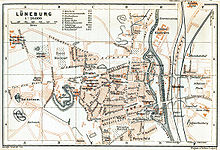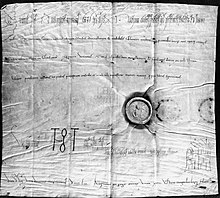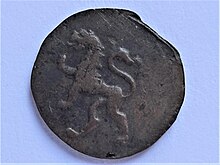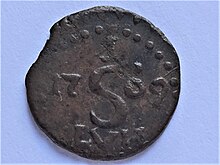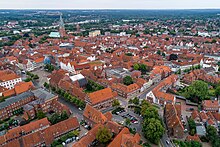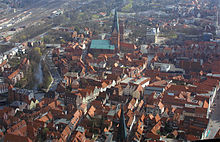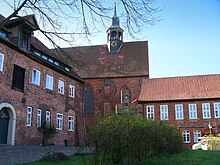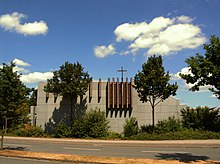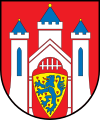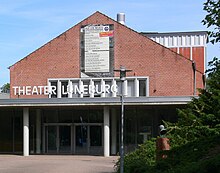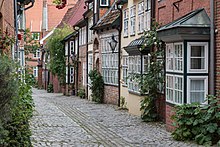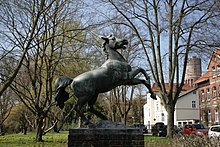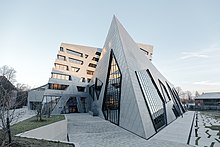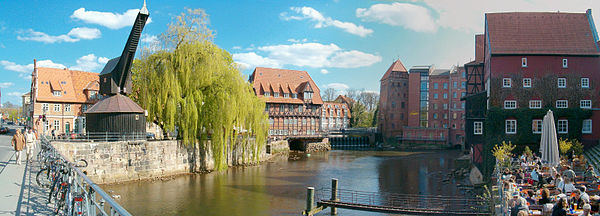Luneburg
| coat of arms | Germany map | |
|---|---|---|
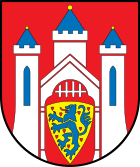
|
Coordinates: 53 ° 15 ' N , 10 ° 25' E |
|
| Basic data | ||
| State : | Lower Saxony | |
| County : | Luneburg | |
| Height : | 17 m above sea level NHN | |
| Area : | 70.34 km 2 | |
| Residents: | 75,711 (Dec. 31, 2019) | |
| Population density : | 1076 inhabitants per km 2 | |
| Postcodes : | 21335, 21337, 21339, 21391 | |
| Area code : | 04131 | |
| License plate : | LG | |
| Community key : | 03 3 55 022 | |
| LOCODE : | DE LBG | |
| City structure: | 17 districts | |
City administration address : |
Am Ochsenmarkt 21335 Lüneburg |
|
| Website : | ||
| Lord Mayor : | Ulrich Mädge ( SPD ) | |
| Location of the city of Lüneburg in the Lüneburg district | ||

The Hanseatic city of Lüneburg ( Low German Lünborg, Lümborg , English [outdated] Lunenburg , Latin Luneburgum or Lunaburgum , Old Saxon Hliuni , Polabian Glain ) is a large medium- sized town in northeast Lower Saxony and one of nine regional centers in the state. The city on the Ilmenau is about 50 kilometers southeast of Hamburg on the edge of the Lüneburg Heath and belongs to the Hamburg metropolitan region . Lüneburg is only about 15 kilometers south of the state borders with Schleswig-Holstein and Mecklenburg-Western Pomerania . The district town of the district of the same name has around 78,000 inhabitants ( agglomeration around 126,000 inhabitants) and has the status of a large independent city .
Lüneburg is the seat of the University of Lüneburg and the Lüneburg University of Cooperative Education, a member of the Lüneburg Landscape Association and was the seat of the administrative district of the same name until the end of 2004 . This was then replaced by a government representative and in 2014 by today's regional representative for north-eastern Lower Saxony.
geography
Geographical location
Lüneburg lies on the lower reaches of the Ilmenau, about 30 km before its confluence with the Elbe . To the south extends the Lüneburg Heath, an area of around 7,400 km², which was created by the felling of large amounts of wood, forest fires and grazing. The often quoted statement that the heather was created by logging for the operation of the Lüneburg salt works is historically not confirmed. It is more likely that human influence began in the Bronze Age . Lüneburg's old town lies above a salt dome , which established the city's wealth and whose plaster cap , the Kalkberg , also represented an excellent building site for the refuge that gave Lüneburg its name.
City structure
The formula Mons, Pons, Fons ('mountain, bridge, source') characterizes the development of the city since the 8th century through the merging of initially three and later four settlement areas. These were the refuge on the Kalkberg - at that time still much higher - with the adjacent branch (Marktviertel), the village of Modestorpe between the bridge over the Ilmenau and the large square Am Sande (Sandviertel) and the saltworks with the closed settlement of the workers employed there (Sülzviertel). It was not until the 13th century that the harbor settlement (water district) was formed between Marktplatz and Ilmenau. The resulting shape of the city remained until the expansion of the city area in the late 19th century and is still clearly recognizable. Lüneburg's six historical city gates were the Altenbrücker Tor, the Bardowicker Tor, the Rote Tor, the Sülztor, the Lüner Tor and the Neue Tor.
Districts
Lüneburg is divided into the districts of Altstadt, Bockelsberg , Goseburg-Zeltberg , Kaltenmoor , Kreideberg , Lüne-Moorfeld , Mittelfeld , Neu Hagen , Rotes Feld , Schützenplatz , Weststadt and Wilschenbruch as well as the villages of Ebensberg , Häcklingen , Ochtmissen , Oedeme and Rettmer. Jüttkenmoor, Klosterkamp, Bülows Kamp, In den Kämpen, Krähornsberg, Schäferfeld, Volgershall, Hanseviertel, Ilmenaugarten and Zeltberg are names for individual building areas within a district or a town.
The subsidence area
The historic quarter between the Lüneburg Saltworks ( German Salt Museum ) and the Kalkberg is a special feature. The houses in this area are located above the salt dome, which is drawn off by the groundwater. This gradually lowered the surface of the earth above the salt dome. After intensification through increased pumping out of brine from the middle of the 19th century, the reduction reached 3–5 cm / year (today up to 3 mm) in changing places. The "subsidence area" was created. Houses and churches on the edge of this area lost their stability and had to be demolished (the Marienkirche in 1818 and the Lambertikirche in 1861). The lowering and, above all, the unprofitable salt production were the reasons for the closure of the salt works in 1980. Only small amounts of brine are now being promoted for the spa operation in the Salztherme Lüneburg (SaLü). The saltworks building houses the German Salt Museum and a supermarket.
The subsidence has been monitored at around 240 measuring points every two years since 1946. The subsidence has not yet come to a complete standstill, the site has been rebuilt and some historic buildings that could be saved have now been restored. The subsidence can still be seen clearly. Visitors who walk from Am Sande to the end of Grapengießerstraße can guess the extent of the subsidence. The depression in front of them used to be level with Grapengießerstrasse.
Further evidence of the earth's movements can be seen in Frommestrasse: the “Gate to the Underworld”, two iron gate wings that have pushed one over the other. Due to the subsidence, two more houses in danger of collapse were demolished in this area in 2012. The gate to the underworld was damaged during the demolition work on the row of houses and was rebuilt in 2014. In the center of the subsidence, the area sagged by 78.5 centimeters from 2010 to 2014. The rate of subsidence has been slowing since 2014. Nevertheless, a house in Egersdorffstraße had to be demolished in 2016, which became unstable overnight due to sudden earth movements.
The consequences of the subsidence can also be seen at Michaeliskirche , on crooked columns and in the tower hall. Further earth movements can currently be observed on the Ochtmisser Kirchsteig.
climate
|
Average monthly temperatures and rainfall for Lüneburg
Source: Klima Lüneburg - Wetterdienst.de
|
||||||||||||||||||||||||||||||||||||||||||||||||||||||||||||||||||||||||||||||||||||||||||||||||||||||||||||||||||||||||
history
prehistory
The first evidence of human presence in the Lüneburg area is dated to the time of the Neanderthals . There are 58 hand axes found at the beginning of the 1990s when the motorway between Ochtmissen and Bardowick was being built . They are around 150,000 years old. The Ochtmiss site is probably a Neanderthal hunting camp , where the early humans cut up their prey. At that time there could be no talk of a continuous settlement of the later urban area; Thousands of years of cold ages prevented this.
The first archaeological evidence of a settled peasant culture was discovered not far from the aforementioned site in the Ilmenau between Lüne and Bardowick. It is an ax that is known as a “shoe last wedge” due to its shape. It is dated to the 6th millennium BC and was part of the Lüneburg museum collection as early as the 19th century.
Since the Bronze Age , the Lüneburg tent mountain has had a number of prehistoric and early historical burial sites that were laid out by the people living in the area of the city of Lüneburg. One of the oldest finds is an "Aunjetitz Edge Ridge Ax". It dates from around 1900 BC. A number of Iron Age urn finds, which are mentioned as early as the 18th century, also come from the city itself . Like those from Lüneburg's Kalkberg, these have found their way into the private collections of some scholars of the 18th century and, with a few exceptions, went down with them.
Worth mentioning in this context are the Lombard urn grave fields from Lüneburg Zeltberg and von Oedeme from the first centuries AD. There are also a number of sites from the early Middle Ages in the area of the later city, for example in the area of the old town of Modestorpe not far from Johanniskirche, the Lambertiplatz near the salt works and in the former water district.
The place Leuphana , mentioned by the Greek geographer Claudius Ptolemäus around 150 AD, could be identical with Lüneburg.
Development from a village to a trading town
The first documentary mention of Lüneburg in the Middle Ages can be found in a document dated August 13, 956, in which King Otto I donated the customs revenue from the Lüneburg salt works to the "monastery built in honor of St. Michael" (teloneum ad Luniburc ad monasterium sancti Michahelis sub honore constructum) . An older mention of the place in the Frankish imperial annals (to the year 795 ad fluvium Albim pervenit ad locum, qui dicitur Hliuni ) refers to one of the three cores of Lüneburg; presumably due to the later castle on the Kalkberg, which was occupied as the seat of the Billunger from 951 . The Elbe-Germanic name Hliuni corresponds to the Longobard word for "refuge".
Due to archaeological finds, some of which are exhibited in the Museum for the Principality of Lüneburg, it is certain that the area around Lüneburg was already settled at that time and that the saltworks had started operating at that time.
The forecast after it was discovered the salt over one thousand years ago by a hunter who had shot a white wild boar. Salt crystals in the fur of the dead animal are said to have drawn his attention to the salt works .
Despite the saltworks, Lüneburg was originally subordinate to Bardowick, just a few kilometers to the north. Bardowick was older and an important trading post with the Slavs . Bardowick's wealth - it had seven churches - also stemmed from the fact that no further trading centers were tolerated. It was only after Bardowick did not want to submit to Heinrich the Lion that it was destroyed by him in 1189. Thereupon Lüneburg got the city charter and developed in place of Bardowick to the central trading place of the area.
The Polish name for Lüneburg is Glain (written as Chlein or Glein in older German sources), probably derived from glaino ( Slavic : glina ) "clay". In Latin texts Lüneburg appears not only as a Latinized Lunaburgum , but also as a Graecized Selenopolis (moon city), an allusion to an etymology that has been popular since the late Middle Ages, which connects Lüneburg with the moon goddess Luna . Coins from this time and the Luna fountain on the market square take up this motif.
Hanseatic period

Due to its long monopoly as a salt supplier in northern Germany , which was only weakened late by salt imports from France , Lüneburg was an early member of the Hanseatic League : Started as a union of individual merchants in Lübeck in 1158, it came to in 1356 (on the first general Hanseatic League ) Federation of commercial cities. The Lüneburg salt was necessary to pickle the herring caught in the Baltic Sea and off Norway and to offer it preserved as a fasting food inland.
The herring market at the Skåne Fair played a major role . Together with Bergen and Visby (the fish suppliers) and Lübeck (the central trading point between the Baltic Sea and the inland) , Lüneburg quickly became one of the most important and richest cities of the Hanseatic League. In the Middle Ages, salt was initially transported overland to Lübeck via the Alte Salzstrasse . With the opening of the Stecknitz Canal in 1398, transport by water to the Lübeck salt storage facility prevailed.
Around 1235 the Duchy of Braunschweig-Lüneburg was established , which was repeatedly divided into different lines and brought together again. The sub-states that emerged again and again and that were in the rank of principalities under constitutional law were usually named after their respective residence. Thus, between 1267 and 1269, a principality of Lüneburg was created for the first time, with Lüneburg as the residential city. In the course of the War of the Lüneburg Succession , insurgent citizens threw the princes out of the city in 1371 and destroyed the lordly castle on the Kalkberg and the nearby monastery. The rights achieved through this and with the peace in 1392 hardly differed from those of a free imperial city, especially in the 15th century; but there has never been any legal recognition of imperial immediacy. These extensive rights could be defended until 1637. The money stayed in the city, the rich houses and churches were built.
In 1392, Lüneburg was granted stacking rights. It forced traveling merchants to go to Lüneburg with their wagons and to “stack” their goods there, that is, to offer them for sale. So that the merchants could not bypass Lüneburg, an impassable landwehr was built around 1397 to the west of the city, and a landwehr to the east was built around 1479.
The Lüneburg Prelate War from 1446 to 1462 meant a crisis , which could only be resolved due to the intervention of the Danish King Christian I , the Bishop of Schwerin and the Lübeck Bishop Arnold Westphal . In 1454, the catalog of demands of the sixties called for more influence of the citizens in public life. Since the end of 2007, Lüneburg has again been given the title of Hanseatic City .
Modern times
Reformation time
During the Reformation , the city turned to the Protestant creed in 1529/1530 , which was intensively promoted by Duke Ernst 'the Confessor' of Braunschweig-Lüneburg .
The oldest trace of the Reformation movement comes from the petition of March 25, 1525 to Elisabeth von Geldern (a daughter of Heinrich the Middle ) of Johann Funke, a citizen exiled from Lüneburg, who had to leave the city because he sang German psalms with others and how others too, had read spiritual and secular Lutheran scriptures. At that time the city still adhered to the old Catholic faith. Troubled years followed, in which the supporters of Rome and the followers of Martin Luther competed against each other.
However, that changed in 1529 and 1530 when Urbanus Rhegius was called to Lüneburg as a reformer, where he arrived in the spring of 1531 and, at the request of the citizens, worked out new school and church regulations. Rhegius soon returned to Celle, but traveled to Lüneburg again and again until 1534 to establish the Reformation, which was confirmed by the signing of the Lutheran formula of concord by the mayor and council in 1580.

A period of highest economic and cultural prosperity followed for Lüneburg, as it had never been reached before and for at least two and a half centuries afterwards.
In 1562 a peace agreement was reached between Lüneburg and the sovereign, to which the dukes Heinrich and Wilhelm , the latter with his wife Dorothea of Denmark , appeared in the city in midsummer of the year . Lush feasts were celebrated with the city leaders in the dance hall of the town hall, a parade was held and gifts were presented to the dukes.
At that time the city became an ornate building with ramparts and ditches, gates and towers up to the Kalkbergveste, guarded by huge guards and grim dogs, with neat streets and squares, the sand with its beautiful tower fountains, the memorable churches (among them the most noble Church of St. Michaelis with its golden plaque ) and cemeteries, the hospitals, the six-tower town hall with the wine cellar, the princely house, the inexhaustible brine well, the harbor, the department store with the crane, the water mills and the water art and general prosperity.
With the decline of the Hanseatic League - and the lack of herrings around 1560 off Falsterbo in Skåne - the big customers for the city's salt broke away; the city rapidly became impoverished. In the following period of economic stagnation hardly any new houses were built.
Thirty Years' War
The Thirty Years War did not affect Lüneburg until 1623, when the city was confronted with troops moving through the country. The council stepped up the guarding of the gates and walls, stored additional food and repaired the parapets of the city wall. War commissioners and men were paid. In 1625/1626 the number of troops passed through, although the city was spared in contrast to the rural areas.
The first plague epidemic flared up relatively mildly in 1624, another broke out at the end of 1625 and raged until 1626. During the most violent phase of expansion in 1626, the maximum number of those buried daily was 50 dead, the mourning bells began in the early morning and only ended in the dark evening. Overall, the number of deaths in the three years is given as 6000, i.e. almost half of the population of Lüneburg, whereby it should be noted that at this time a large number of people from the surrounding area had fled to the city.
Despite marching through troops like General Tilly's in 1627 , Lüneburg was spared, but had to pay 33,600 Reichstaler war contribution from 1628 to 1629 alone . At the same time the income from the brawn and, for example, from the beer excise sank , so that the city treasury noted that it had never had such low income before.
The city council rejected the request of Duke Georg von Braunschweig and Lüneburg-Calenberg to set up a princely garrison in 1631 , or of the Swedish General Tott to accept an occupation. In 1635, General Banér bought himself free from the Swedish occupation by General Banér for 10,000 Reichstaler, who, however, again included the city with troops in the following year and coveted the city for himself. After initial resistance, the city gave in and was forced to meet further tough conditions. For example, a looting of Lüneburg by soldiers had to be replaced with 34,000 Reichstalers. In order to raise this high sum, over 200 pieces of the council silver treasure had to be turned into money. Since the sale had to take place at the worst possible times and in a hurry, the 5,000 Reichstaler earned for it could hardly have corresponded to the pure material value.
In addition, since the beginning of the Thirty Years' War, an internal dispute had arisen within Lüneburg's walls and council, in which the supremacy of the traditional patrician upper class had on the one hand become weaker and the craft guilds and simple citizens demanded access to the council. There were old tensions between the Council and the Citizens' Committee for various reasons. The council consisted of the rich upper class, who mostly provided the soup and bar masters, and was not freely elected. This class, which represented the municipal regiment, had inherited its position like the nobility, while the civil council was composed of craftsmen and guilds. Charitable status, especially in foundations and the like, for which the previous patriciate and the Sülfmeister were responsible, was thwarted in favor of personal enrichment, the income and prosperity of the city continued to decline.
When the main Swedish troops finally left Lüneburg, they left only a few soldiers behind to protect the city. At the same time, imperial , Electoral Saxon and Kurbrandenburg troops craved the city. Was threatening as the location for the leached city in August 1637, the desperate citizens of Lüneburg, Duke George of Brunswick-Lüneburg decided to open the gates to an enemy taking and pillage to escape.
Lüneburg was never a free imperial city in the sense of constitutional law , although the emperors themselves and their chancellery were in the dark, but in fact still had this status and in its freedom and in its wealth it was the dukes of Braunschweig-Lüneburg since the loss of their castle Kalkberg 1371 a thorn in the side. On September 3, 1637, the Duke and three companies entered Lüneburg, which was handed over to him without a fight by the Swedish Colonel Stammer (who was executed in Wismar on the orders of General Banér).
In December 1637, the duke deposed the patrician council of Lüneburg, "because he acted to capture the Swedes without the participation of the citizens and to the displeasure of the princely house." However, the new council did not prove to be able to act, so that the citizens again demanded the establishment of the old patrician council. Tough negotiations followed between the mayors and the council of Lüneburg on the one hand and the Princely House on the other, until Duke Georg von Braunschweig-Lüneburg fully enforced his new position in May 1639:
Mayors and councilors, old and new, the three ordines and all guilds, guilds and guilds with the entire citizenry had to swear submissiveness and obedience to the princes of Braunschweig-Lüneburg as their immediate high authorities superposed by God. The shift in the balance of power in favor of the Princely House of Braunschweig-Lüneburg became clearest, on the one hand, in the stationing of a city governor and 75 men assigned to him, who were committed to both the regional prince and the civil parish, and, on the other hand, in the cession of the Kalkberg, which he received in 1371 princely festivals had been conquered by the citizens of the city and "to which the proudest memories of every citizen adhered, whom the city once conquered with cunning and violence, but then honestly bought with large sums". All of the city and wall towers that blocked the unobstructed view of Lüneburg from the Kalkberg had to be torn down. The craftsmen were admitted to the city council, but the long-established patrician families were still entitled to half of the council seats and the first two mayors were also appointed from their ranks.
Lüneburg suffered the loss of its freedom and the supremacy of the previously ruling patriciate was broken forever, which is still reflected in the buildings of the city, which displayed the wealth of the patrician families of Lüneburg until around 1620, after which they were hardly ever of this size and splendor have been erected. In addition, the city was extremely heavily in debt, so that in 1682 taxes had to be increased "to pay off war debts and other debts". The city of Lüneburg still minted coins into the 18th century. 2/3 thalers were still minted in 1702, their own copper small change, the Scherf , until 1777.
19th and 20th centuries
In 1810, Lüneburg was annexed to France ; the French era began. When, in March 1813, after the defeat of the French in Russia, a general uprising broke out in northern Germany, the Lüneburgers chased the French officials out of their city. The result was the battle near Lüneburg on April 2, 1813.
Heinrich Heine , whose parents lived in today's Heinrich Heine House in Lüneburg from 1822 to 1826 , called it his “residence of boredom”. Towards the end of the 19th century, Lüneburg became what it was as a garrison town ( Theodor-Körner-Kaserne ).
200 Jewish Lüneburg was founded in 1894 by the Jewish community in Lüneburg the synagogue at the corner of Wall Schiffer / Reichenbach road inaugurated. Jewish residents of Lüneburg were actively involved in the economic and cultural development of Lüneburg.
After the seizure of power of Hitler the non-cooperation of all Jews in public life boycotted . Jews were expelled, deported to concentration camps and murdered . In Lüneburg, 26 stumbling blocks remind of the fate of victims of the Nazi regime . City tours of the Lüneburg History Workshop lead to some of the former places of residence, study and work of Lüneburgers who were victims of National Socialism , as well as to places in Lüneburg that played an important role during the National Socialist era .
In the children's department in Lüneburg, part of the Lüneburg State Sanatorium and Nursing Home , over 300 children were probably killed as part of " child euthanasia " during the Second World War .
By air strikes on Luneburg only relatively minor damage incurred. In the night of August 12th to 13th, 1941, bombs fell on Lüneburg for the first time, with various houses in the Im Grimm district being destroyed and others damaged and two people injured. On April 2, 1944, scattered bombs hit Lüneburg at night, killing several people and destroying two residential buildings on Bleckeder Landstrasse and one on Lüner Weg. A memorial in the zoo near the train station reminds of a mass grave of 256 concentration camp prisoners, whose transport from a satellite camp of Neuengamme concentration camp in Wilhelmshaven was bombed here on April 7, 1945. Victims of April 11, 1945 are also buried here. Up to 80 of the injured and weakened but living prisoners who were not to be transported were shot dead by marines in a mass murder. At noon on April 18, 1944, the air base was attacked by around 30 aircraft and severely damaged. A total of 43 houses were completely destroyed in Lüneburg during World War II. 270 apartments became uninhabitable, which corresponds to a degree of destruction of 2.6%. A total of 11,200 m³ of rubble was removed.
On the evening of May 4, 1945, an authorized delegation of the last Reich government in Flensburg - Mürwik signed the partial surrender of the German troops in Northern Germany, Denmark, Norway and the north of Germany, Denmark, Norway and the Timeloberg (near the village of Wendisch Evern ) in the presence of Field Marshal Montgomery in the headquarters south of Lüneburg northern Netherlands, i.e. by far the largest part of the territory still held by German troops at the time, which in fact ended the fighting there. The site is inaccessible to the public in a restricted military area ; a small memorial stone on a nearby dirt road commemorates the surrender. Shortly afterwards the unconditional surrender of the Wehrmacht followed . On May 23, 1945, Reichsführer SS Heinrich Himmler committed suicide while in British captivity in Lüneburg by chewing a cyanide capsule.
post war period
Even before the Nuremberg trial of the main war criminals , the first war criminals trial began in Lüneburg on September 17, 1945, the so-called Bergen-Belsen trial , in which 45 people were charged.
The deterioration of the building structure after the end of the Second World War led to various considerations as to how the quality of living could be improved. A seriously discussed proposal was to tear down the entire old town and replace it with modern buildings. As a result of the citizens' protest that followed, Lüneburg became one of the focal points for a new idea: monument protection . The city has been systematically restored since the early 1970s. In the late 1960s, Curt Pomp made a special contribution : Against numerous opposition from politics and administration, he campaigned for the preservation of historical buildings in the Lüneburg Old Town working group that he founded. His commitment was rewarded with the German Prize for Monument Protection and the Federal Cross of Merit. Due to these restorations - 1300 brick houses are listed - the Lüneburg old town is a tourist attraction; important parts of the economy are geared towards tourism.
As part of the planned reform two of the three have been since 1990 Bundeswehr - barracks closed the city and reduced the remaining. In addition, the Federal Border Guard barracks, which are used in part by the Lower Saxony state riot police (4th operational hun- dred ), were closed. The Lünepark is being built on the site of the former Federal Border Guard barracks with new commercial space for start-ups. Business development and many companies from the IT sector have already settled here. Nearby, the Johannes Westphal Bridge was opened to traffic in May 2006. This connects the newly created Lünepark with the Goseburg district on the other side of the Ilmenau .
The University of Lüneburg was relocated to the site of the former Scharnhorst barracks. The University of Lüneburg developed from the University of Education (PH), which was converted into an independent academic university with the right to qualify as a habilitation in 1978 and renamed the University of Lüneburg in May 1989. Since moving to the former barracks, the university has attracted more and more students. The expansion of the university is an important contribution to the restructuring of the city into a service center.
As a result of the regional reform of 1972, Lüneburg lost its status as an independent city and was incorporated into the Lüneburg district. On October 5, 2007, the name was changed from the city of Lüneburg to the Hanseatic city of Lüneburg and thus, along with Stade, the only Hanseatic city in Lower Saxony to date .
On September 23, 2008, the city received the title “ Place of Diversity ” awarded by the federal government .
Incorporations
- 1943: Hagen and Lüne
- 1974 (March 1st): Häcklingen , Ochtmissen , Oedeme and Rettmer as well as parts of the Alt-Hagen and Pflegerdorf / Gut Wienebüttel area
- 1974 (April 1): Ebensberg and Olm parts of the municipality of Adendorf
Population development
Lüneburg already had around 14,000 inhabitants in the late Middle Ages and at the beginning of the modern era , making it one of the major cities of that time. With the economic decline, the population fell to 9,400 by 1757 and rose to 10,400 by 1813. With the onset of industrialization in the 19th century, population growth accelerated. In 1855 only 13,000 people lived in the city, by 1939 there were already 35,000. Shortly after the Second World War, refugees and displaced persons from the German eastern areas brought the city an increase of 18,000 people to 53,000 inhabitants in December 1945. In 2003, the population of the city exceeded the limit of 70,000. The city of Lüneburg as well as its district and the neighboring district of Harburg are among the few areas in Germany that are characterized by strong population growth. Reasons for this include the growth in and population shifts to the outskirts of the Hamburg city region . The Lower Saxony State Office for Statistics has predicted a population of 89,484 for the city of Lüneburg by 2021.
On December 31, 2015, the official population for Lüneburg was 74,072 according to an update by the Lower Saxony State Office for Statistics (only main residences and after comparison with the other state offices) - a historic high. Furthermore, Lüneburg has particularly close relationships with the immediately neighboring communities that are growing together with the core city, with which it forms an agglomeration. With the towns of Adendorf , Bardowick , Deutsch Evern and Reppenstedt as well as Vögelsen and Wendisch Evern, the city has a population of around 108,000 and, together with these localities, would have the population required for a large city . Lüneburg is currently the eleventh largest city in Lower Saxony.
The following overview shows the number of inhabitants according to the respective territorial status. Up to 1813 these are mostly estimates, then census results ( 1 ) or official updates from the State Statistical Office. From 1871, the information relates to the “local population”, from 1925 to the resident population and since 1987 to the “population at the location of the main residence”. Before 1871, the number of inhabitants was determined according to inconsistent survey procedures.
| year | Residents |
|---|---|
| 1530 | 14,000 |
| 1699 | 11,000 |
| 1757 | 9,426 |
| 1813 | 10,400 |
| 3 December 1855 1 | 13,352 |
| 3 December 1861 1 | 14,400 |
| 3 December 1864 1 | 15,700 |
| 3 December 1867 1 | 15,900 |
| December 1, 1871 1 | 16,284 |
| December 1, 1875 1 | 17,500 |
| December 1, 1880 1 | 19,100 |
| December 1, 1885 1 | 19,336 |
| December 1, 1890 1 | 20,665 |
| December 2, 1895 1 | 22.309 |
| 1 December 1900 1 | 24,693 |
| December 1, 1905 1 | 26,571 |
| year | Residents |
|---|---|
| December 1, 1910 1 | 27,790 |
| December 1, 1916 1 | 23,799 |
| December 5, 1917 1 | 23,282 |
| October 8, 1919 1 | 27,579 |
| June 16, 1925 1 | 28,923 |
| June 16, 1933 1 | 31,171 |
| May 17, 1939 1 | 35,239 |
| December 31, 1945 | 53,095 |
| October 29, 1946 1 | 49.169 |
| September 13, 1950 1 | 58,139 |
| September 25, 1956 1 | 56,845 |
| June 6, 1961 1 | 59,563 |
| December 31, 1965 | 60,269 |
| May 27, 1970 1 | 59,516 |
| December 31, 1975 | 64,586 |
| December 31, 1980 | 62,225 |
| year | Residents |
|---|---|
| December 31, 1985 | 59,645 |
| May 25, 1987 1 | 59,543 |
| December 31, 1990 | 64,857 |
| December 31, 1991 | 65,586 |
| December 31, 1992 | 66.054 |
| December 31, 1993 | 65,525 |
| December 31, 1994 | 65,926 |
| December 31, 1997 | 67,372 |
| December 31, 1998 2 | 67,920 |
| December 31, 1999 2 | 68,554 |
| December 31, 2000 2 | 69,413 |
| December 31, 2001 2 | 70,395 |
| December 31, 2002 2 | 70.503 |
| December 31, 2003 2 | 69,718 |
| December 31, 2004 2 | 70.128 |
| December 31, 2005 2 | 70,667 |
| year | Residents |
|---|---|
| December 31, 2006 2 | 70.931 |
| December 31, 2007 2 | 71.119 |
| December 31, 2008 2 | 71.179 |
| December 31, 2009 2 | 71,303 |
| December 31, 2010 2 | 71,549 |
| December 31, 2011 2 | 72.040 |
| December 31, 2012 2 | 72,572 |
| December 31, 2013 2 | 73.149 |
| December 31, 2014 2 | 72,546 |
| December 31, 2015 2 | 74,100 |
| December 31, 2016 2 | 76.164 |
| December 31, 2017 2 | 77.143 |
| December 31, 2018 2 | 77,539 |
| December 31, 2019 2 | 78.024 |
religion
According to the 2011 census , 45.6% of the population were Protestant , 9.1% Roman Catholic and 45.3% were non-denominational , belonged to another religious community or did not provide any information.
Lüneburg is the seat of a church district. The three remaining historic town churches St. Johannis , St. Michaelis and St. Nicolai are Protestant. The Lüne parish uses the historic St. Bartholomäi Church of the Lüne Monastery in the Lüne-Moorfeld district and the parish hall in Ebensberg . Modern churches in Lüneburg are the Kreuzkirche am Bockelsberg , the Martin-Luther-Haus with church hall from the 1950s in Goseburg-Zeltberg , the Paul-Gerhardt-Kirche from 1963 in Neu Hagen and the Pauluskirche from 1971 on the Kreideberg .
The oldest ecumenical community center (Protestant and Catholic church under one roof) in Germany has been located in the Kaltenmoor district since 1974: St. Stephanus .
In addition to the St. Marien Church , the churches in Kaltenmoor , Adendorf and Amelinghausen also belong to the Catholic parish of St. Marien . With the influx of refugees and displaced persons after the Second World War, the number of Catholics in Lüneburg increased, so that St. Mary's Church, built in Wallstrasse in 1857, became too small and was demolished in 1968. As a replacement, a new building was inaugurated on Friedenstrasse in 1963.
There are also other Christian congregations in Lüneburg: the New Apostolic congregation was founded in 1882, and its current church in the Rotes Feld district was inaugurated in 1959. The Evangelical Free Church Community ( Baptists ), founded in 1894, belongs to the Federation of Evangelical Free Church Congregations , and the Friedenskirche in the Bockelsberg district belongs to it . The Adventist church, which has existed since 1912, has had the church in Friedenstrasse since 1980. The St. Thomas Congregation was founded in 1927 and belongs to the independent Evangelical Lutheran Church , its church is located on the Springintgut on the northwestern edge of the old town. The Evangelical Reformed parish of Lüneburg-Uelzen was founded in 1958, and the Christ Church in Kaltenmoor in Lüneburg belongs to it . The Free Evangelical Community of Lüneburg was founded in 1991 and is based in Neu Hagen . The Free Christian Community of Lüneburg (Pentecostal Church) has its seat in Wedekindstrasse in the Schützenplatz district , the Matthäusgemeinde with the parish hall on Kalkberg is an independent Protestant free church and belongs to the Mülheim Association of Free Church Evangelical Congregations .
There is a chapel in the Lüneburg Psychiatric Clinic , and church services are also held in the Municipal Clinic. The 16th century chapel on Gut Schnellenberg is privately owned.
The large synagogue on Schifferwall, inaugurated by the Jewish community in 1894, was sold for demolition in 1938. A memorial stone has been commemorating the site since 1955.
There are also Muslims living in the Hanseatic city of Lüneburg. The majority of the Muslim inhabitants live in the most populous district of Kaltenmoor . There is also a Turkish-Islamic community in Lüner Weg in the Hanseatic city (DITIB-Turkish Islamic Community of Lüneburg eV).
politics
The city of Lüneburg belongs to the state electoral district 49 Lüneburg and to the federal electoral district 38 Lüchow-Dannenberg - Lüneburg .
advice
The council of the Hanseatic City of Lüneburg consists of 42 councilors and the mayor. After the 2016 municipal elections, the council will be composed as follows:
| year | SPD | CDU | Green | left | FDP | AfD | total |
|---|---|---|---|---|---|---|---|
| 2016 | 14 seats | 9 seats | 9 seats | 4 seats | 2 seats | 4 seats | 42 seats |
Lord Mayor and Mayor
Before the Second World War, the mayor was the full-time head of the city administration. With the introduction of the North German Council Constitution by the British occupying power, the city elite separated: the honorary mayor and chairman of the city council was the political representative of the city, who, like all members of the city council, was elected by the population, while the administration was carried out by the full-time city director , elected by the city council. As a result of the reform of the municipal constitution, both tasks have been (again) combined in the office of the full-time mayor, who is now directly elected by the population.
|
|
In addition to the mayor, there are honorary mayors (elected by the city council) who support and represent the mayor in his protocol-related tasks. Current mayors are Eduard Kolle (SPD), Ulrich Löb (Greens) and Christel John (CDU).
City Director
In 1946 the British occupation forces introduced dual leadership in local government. Until 1996 there was the senior city director in Lüneburg as head of administration.
- 1946–1955: Werner Bockelmann , SPD
- 1955–1963: Walter Bötcher , FDP
- 1963–1984: Hans Heinrich Stelljes , independent
- 1984–1996: Reiner Faulhaber , CDU
Since 1996 the administration has been led by the mayor.
coat of arms
| Blazon : “In a red shield. Inside there is a crenellated silver castle with three towers that are blue-roofed and each end in a golden knob. In the red gate opening with portcullis stands an upright, red-tongued and red-armored blue lion with a face to the right in a golden shieldsprinkledwith red hearts . " | |
| Foundation of the coat of arms: The city wall with towers symbolizes the defensive strength of the city and the sovereignty of the city. The lion with the hearts is taken from the coat of arms of the principality of Lüneburg and shows the affiliation of the Hanseatic city to this principality. |
Town twinning
Despite its medium size, Lüneburg maintains numerous partnerships with other cities. In June 2000, delegates from all twin cities met in Lüneburg and the surrounding area and celebrated the largest partnership meeting of the post-war period in this region.
- Scunthorpe , United Kingdom , since 1960
- Naruto , Japan , since 1974
- Clamart , France , since 1975
- Ivrea , Italy , since 1988
- Viborg , Denmark , since 1992
- Tartu , Estonia , since 1993
In addition, there are various domestic German partnerships, for example with Kulmbach and Köthen .
Culture and sights
theatre
The Lüneburg Theater is one of the smallest three-branch theaters in Germany. Not only plays of all styles are performed, but also operas, operettas, musicals and ballet.
In addition, Lüneburg has a large number of amateur stages that also regularly produce performances. The first of these theaters was dat - the other theater founded in 1973 , which until 1978 made a name for itself with current children's plays, studio productions and alternative theater experiments. Today's diversity in the amateur theater sector is otherwise only available in much larger cities such as Hamburg or Hanover. A small selection (sorted by year of foundation):
- Low German stage Sülfmeister
- Kleines Keller Theater e. V.
- Amateur theater spotlight e. V.
- Theater spotlight
- theater im e.novum: a small private theater in which various ensembles of amateur artists play
- Kulturforum Gut Wienebüttel and Kulturbäckerei Lüneburg
Museums
The historic city is an open-air museum ("Rothenburg des Nordens"), and is also animated by museums. The most important museums are the German Salt Museum in the buildings of the former saltworks, in which the importance of salt in the Middle Ages and salt production is presented, the East Prussian State Museum , which shows the culture and history of German East Prussia and the Baltic Germans. In the immediate vicinity is the brewery museum , which in the former brewhouse of the Kronen brewery deals with the history of beer brewing in Lüneburg. The history of the city and the surrounding area is presented in the Lüneburg Museum . The Halle für Kunst Lüneburg exhibits contemporary art.
Buildings

Lüneburg is one of the few cities in northern Germany that was able to save its historical core undamaged by the Second World War. However, the neglect of the building fabric well into the 1960s and the damage in the subsidence area led to gaps in the historic cityscape. In addition, in the 1950s and 1960s, the demolition of ailing buildings and the construction of department stores with a (then) modern character caused the appearance of many streets to break. Lüneburg has been carefully and lovingly restored since the early 1970s. As a result, previously hidden ceiling paintings, medieval pottery rooms and many historical septic tanks have now been discovered, which gave a much better picture of life in the Middle Ages.
Particularly noteworthy buildings are the three remaining town churches St. Johannis am Sande (construction started in 1289, completed in 1470), the church St. Michaelis , in which Johann Sebastian Bach was a choirboy from 1700 to 1702, and the town church St. Nicolai , which was built from 1407 has been. The Lambertikirche had to be demolished as early as 1861 because it was dilapidated: it was in the subsidence area. Its Sunday bell from 1712 and the clockwork can be found today in the roof turret of the Heiligengeistschule, the old “Spital zum Heiligen Geiste”, which serves as a senior citizens' institution and elementary school.
The historic town hall of Lüneburg with its famous court arbor, the former council chamber, which was designed by an unknown master , can be regarded as one of the most outstanding architectural monuments in northern Germany . It was started around 1230, expanded over the centuries and is considered the largest medieval town hall in northern Germany. In the town hall tower there is a porcelain carillon with 42 bells made of Meissen porcelain . The Lunabrunnen in front of the town hall is adorned with a bronze statue of the moon goddess with a bow and arrow; the original from 1532 was stolen and melted down in 1970; today's bust is a replica from 1972. Also on the market is the former Lüneburg Castle of the Dukes of Braunschweig-Lüneburg , which has housed the regional court since 1925. The bell house (old armory) at the Glockenhof and the old Raths pharmacy from 1598 in Große Bäckerstraße are just as interesting .
In the area of the old harbor there is still the baroque facade of the old department store , the remaining parts of which burned down and had to be replaced by a new building (appropriately for the fire brigade) and is now used as a hotel, and the old crane , one to this day Functional medieval wooden construction, inside of which two large running wheels allow the crane rope to be raised and lowered. The volunteer fire brigade was relocated to new buildings on the outskirts of the city center in autumn 2007, and a hotel has now moved into the old department store.
There are no traces of the eponymous Lüneburg on the Kalkberg , which, thanks to gypsum mining, also gives little indication of its former size. On the southern edge of the city center is the Lüneburg water tower , which today serves as a lookout tower . In front of the gates of the old city there is also the Lüne Monastery , a former Benedictine monastery . It was built from 1172 and is well restored.
The central building and Audimax Leuphana University of Lüneburg, which opened in 2017, was designed by Daniel Libeskind . Lüneburg also uses the Audimax as a town hall. The foundation stone was laid on May 8, 2011, and construction work on the 37-meter magnificent building dragged on for almost seven years. The new main building was originally supposed to open at Easter 2014. At that time, however, the shell was not even finished; only three of the seven planned floors were sticking out.
About two kilometers west of Lüneburg, in the villages of Reppenstedt and Vögelsen , there is a well-preserved section of the Lüneburg Landwehr monument , which can also be hiked.
St. Nicolai in the water district
Old port with crane and department store
Am Sande, view to the west of the Lüneburg (main) seat of the Lüneburg-Wolfsburg Chamber of Commerce and Industry
"Bach Church" St. Michaelis
Sports
One of the oldest records of football in Germany is available from Lüneburg . While Konrad Koch let his students play rugby in Braunschweig from 1874, the first football game was played at the Johanneum in Lüneburg on August 28, 1875. An article in the English weekly magazine “The Field, the farm, the garden. The country gentleman's newspaper reported about it on September 4, 1875 with the names of all players. The protagonists of this soccer game were the Lüneburg teacher Wilhelm Karl Philipp Theodor Görges (1838-1925) and the young Englishman Richard Ernest Newell Twopeny (1857-1915). Several games are documented, the first one reported in the Lüneburgsche Anzeiger in September 1875. The club founded at the Johanneum only existed for a short time and was forgotten. A comprehensive overview was published in 2016 about the further development of football in Lüneburg.
- The Lüneburger SK Hansa playing with her football team in the fourth division Regionalliga Nord .
- MTV Treubund Lüneburg v. 1848 is the largest sports club in the region with 6,000 members. The soccer team plays in the sixth class Lüneburg regional league.
- SV Eintracht Lüneburg, plays with the soccer team in the sixth class Landesliga Lüneburg.
- VfL Lüneburg, currently with the soccer team in the sixth class Landesliga Lüneburg.
- The SVG Lueneburg is a volleyball club whose men's team from 2009 to 2014 in the 2. Bundesliga played and in the since 2014 1. Bundesliga plays.
- Handball club Lüneburg: founded in 2008, it has 350 members. The men's first team plays in the Lower Saxony Association League, while the women's team plays in the Lower Saxony Oberliga .
- The Salt City Boars Lüneburg currently play inline skater hockey in the 2nd Bundesliga North
Regular events
- April: spring market on the Sülzwiesen; Lüneburg Motorhome Days
- June: City festival
- June: Lunatic Festival : non-profit music festival on the campus, Coraci Festival (formerly Sonar): political festival of the AStA on the campus; Lüneburg Children's Festival
- July: Religious Street Festival
- September: Oktoberfest on the Sülzwiesen.
- Beginning of October: Sülfmeistertage
- November: Night of the clubs
- Christmas time: Christmas city Lüneburg - historical Christmas market around the St. Michaeliskirche, Christmas market in front of the town hall, fairytale mile through the city center, project Lüneburg is lit (gable lights around the market square, in Grapengießerstraße and Am Sande).
In 2012 the Hanseatic Days took place in Lüneburg .
Culinary specialties
Lüneburg is known for special dishes: the Heidschnuckenbraten and the smelt . A small fish that is in season in spring. Another culinary rarity is a regionally different, Danish-influenced variant of Labskaus ( Skipperlabskovs , colloquially also Gammel danske kaus).
Lüneburg once had over 80 breweries . The "Lüneburger Kronen-Brauerei von 1485" in Heiligengeiststraße brewed well-known beers in northern Germany such as the "Lüneburger Kronen-Pilsener" and the "Moravia Pilsener". These beers are brewed by Holsten-Brauerei AG in Hamburg, but the original yeast strains were destroyed when the Kronen Brewery was taken over. Only the original “Lüneburger Pilsener” is still available, although this has now also been produced by Holsten-Brauerei AG in Hamburg and has now only been sold in barrels. Since March 2011, “Lüneburger Pilsener” has been sold in bottles again in cooperation with the Holsten-Brauerei AG Hamburg. There are two smaller breweries in Lüneburg. The tradition of Lüneburg breweries continues in the Nolte pub brewery on Dahlenburger Landstrasse and in the Mälzer brewery and table house on Heiligengeiststrasse.
Economy and Infrastructure
Lüneburg has developed into a focal point for tourists from all over the world in recent years. The medium-sized manufacturing industry and small businesses play a role in Lüneburg's economic life. Changes and impulses result from the University of Lüneburg , which contributes to the vitalization of the region with its students.
Companies
Industry and craft
Many small and medium-sized companies are based in Lüneburg.
Worth mentioning are the fashion manufacturer Roy Robson in the textile sector (the knitwear manufacturer Lucia, once the city's largest employer, filed for bankruptcy in 2008), and in the food sector DE-VAU-GE Gesundkostwerk, one of the largest German manufacturers of vegetarian foods , Pickenpack Production Lüneburg GmbH (formerly Pickenpack Hussmann & Hahn Seafood GmbH) as one of the leading European companies in the frozen fish sector (part of Pacific Andes International Holdings Limited , Hong Kong) and the Lünebest dairy , which is part of Hochwald Foods . In the industrial sector, the resident companies of the car interior decorator Yanfeng Automotive Interiors , HB Fuller, Impreglon SE and the supplier of industrial electronics are Sieb & Meyer AG. In Lüneburg, the von Stern'schen print shop, founded in 1614, is the oldest family-owned print shop in the world.
tourism
In Lüneburg, next to the spa center, there is a spa park with a graduation tower, ponds, flower beds and a herb garden. The spa center includes the salt thermal bath with sea water wave pool, wellness and sauna world ( SaLü ), and there is also a saltwater therapy area with applications for skin and respiratory problems. Lüneburg is not a health resort, but has special remedies, such as Lüneburg brine (about 26% salt content), with which people suffering from psoriasis can experience relief.
There are other green areas around the Kreidesee, on the Kalkberg, in the Liebesgrund, in the Clamart Park, at the Lüne Monastery, in the Ilmenau lowlands and in the Hasenburger Bachtal.
The head office of the Seminaris conference hotel group has been located in Lüneburg since 1978 .
New technologies and services
In the field of technologies and services, the innovation and start-up center e-novum should be mentioned, which deals with the promotion of young companies. Werum Software & Systems AG is the largest company in the information and communication technology sector . The Landeskrankenhilfe , Volksbank Lüneburger Heide and Sparkasse Lüneburg are located in Lüneburg .
media
The Norddeutsche Rundfunk (NDR) broadcasts regional information for Heath and Wendland, the south of Hamburg and the Lower Elbe in the NDR 1 Lower Saxony program several times a day from the Lüneburg studio . In addition, the editorial team supplies other NDR stations and the entire ARD for major events such as the Elbe flood or Castor transports. With Radio ZuSa there is a local radio station whose programs are produced and broadcast in Lüneburg and Uelzen .
In 2006, the film production company Studio Hamburg Traumfabrik Niedersachsen GmbH set up its headquarters and two production studios in the former European headquarters of Konica Minolta in the Hafen industrial area. The telenovela Rote Rosen has been produced for Das Erste since August 28, 2006 . Lüneburg is the seat of the Society for Visual Communication, the largest communication agency in Lower Saxony. The company's main focus is on trade and sales marketing. The regional newspaper for the Lüneburg Heath is the local daily newspaper for the Lüneburg district and neighboring areas. The “Lüneburger Rundschau” appeared until August 11, 2012 as a daily local edition of the “ Hamburger Abendblatt ”.
Lüneburg is the hometown of the Tatort chief inspector Charlotte Lindholm (played by Maria Furtwängler ). In the episodes “Heimspiel” and “ Black Tiger, White Lions ”, Lindholm is mostly visiting her mother, and the criminal case develops from this. Lüneburg was the scene of a crime scene episode as early as 1977. At that time, chief detective Heinz Brammer (played by Knut Hinz ) determined in the episode " The silent business ". In autumn 2017, another episode was filmed in Lüneburg with Tatort commissioners Falk ( Wotan Wilke Möhring ) and Grosz ( Franziska Weisz ).
Lüneburg was the main location for the fairytale film " The Crown of Arkus ".
Public facilities
Lüneburg is the seat of the Lower Saxony Higher Administrative Court , a regional court and the first instance district court , the Lüneburg government representative as the successor to the district government that was dissolved on January 1, 2005 , the Lüneburg-Wolfsburg Chamber of Industry and Commerce , the Braunschweig-Lüneburg-Stade Chamber of Crafts and the Lüneburg Police Department Police inspection Lüneburg / Lüchow-Dannenberg / Uelzen and the federal police station Lüneburg. The old garrison town (until 1914 was the Dragoons. 16 in the Lüner barracks) is to have an important site of the Federal Armed Forces , even though the number of soldiers stationed there since the 1990s, from about 9000 to today around 1,000 soldiers has decreased. The University of Lüneburg has moved into the former Scharnhorst barracks. In one part of the Schlieffen barracks, authorities such as the administrative court, the labor court, the social court, customs, the tax investigation department and the land registry office are located. The reconnaissance training battalion 3 "Lüneburg" (up to June 2007: armored reconnaissance training battalion 3 ), the medical center Lüneburg, a driving school company and some small offices are stationed in the Theodor-Körner-Kaserne .
Healthcare
The Lüneburg Municipal Clinic exists in Lüneburg . This hospital participates in the Elbe-Heide-Krankenhausverbund, which includes several clinics in the southern Hamburg area. The Lüneburg Psychiatric Clinic is located on Wienebütteler Weg , a company in the Lüneburg health holding . Another institution in Ochtmissen is the Loewe Foundation, which enables mentally ill people to return to work.
Social facilities
One provider of social services in Lüneburg is the AWO -Regionalverband Lüneburg / Uelzen / Lüchow-Dannenberg, whose offers cover almost all social work fields. The Lebenshilfe Lüneburg-Harburg care and encourages people with disabilities in the region. A socially oriented company is Neue Arbeit Lüneburg-Uelzen gGmbH within Diakonie Deutschland . Their main task is to integrate the long-term unemployed, single women and people over 50 into the primary labor market.
There is a wide range of 120 self-help groups in the city. The volunteer agency mediates voluntary and civic engagement with social institutions in the city.
education
The first school in Lüneburg was the Michaelis School founded in the 14th century . There are four grammar schools in Lüneburg . In addition to the Herderschule , the Wilhelm Raabe School and the Gymnasium Oedeme , the Johanneum Lüneburg, founded in 1406, is one of the traditional schools in Germany. In addition to the elementary, secondary and secondary schools, the three vocational schools on Schwalbenberg are important. The adult education center (Haagestrasse 4) has a place in the educational offer. There is a Rudolf Steiner School and a Montessori Primary School .
The University of Lüneburg, founded in 1989 (formerly the University of Education ), which was located in the buildings of one of the disbanded barracks, and the center of the Northeast Lower Saxony University of Applied Sciences (with study locations in Lüneburg, Suderburg and formerly Buxtehude ) help with the restructuring of the city from a garrison town to a service center.
Since January 1st, 2003 the university has been a foundation under public law. On January 1, 2005, the university and the technical college were merged under the umbrella of the University of Lüneburg Foundation. With the reorientation of the University of Lüneburg, it was renamed Leuphana University of Lüneburg on March 21, 2007 . As a special attraction, the new main building of the university opened in March 2017, which is based on a design by the architect Daniel Libeskind .
One of the largest extracurricular educational institutions is located in the Bockelsberghütte. This youth education center, located in the Bockelsberg district, is one of the few free-standing half-timbered houses in Lüneburg and, after its renovation, houses several independent youth welfare organizations.
The Braunschweig-Lüneburg-Stade Chamber of Crafts maintains a technology center (TZH) at the Lüneburg location for vocational training and further education in skilled trades. The TZH Lüneburg has 43 workshops with 639 workplaces and 17 classrooms with 402 places. Every year around 10,000 trainees are trained there in 23 different trades as part of the technological apprenticeship qualification. In addition, there is master craftsman training for around 700 and technical training for around 2,000 craftsmen every year. The TZH has a guest house with 81 rooms and 213 beds, in which over 35,000 overnight stays take place annually.
traffic
railroad
The city and district of Lüneburg have been part of the Hamburg Transport Association since December 2004 . The Lüneburg train station is on the Hanover – Hamburg railway line and is served by trains operated by Deutsche Bahn AG , erixx GmbH and the Metronom Eisenbahngesellschaft . The journey time to Hamburg Central Station is around 30 minutes. In addition to regional trains, Intercity trains and ICE also stop in Lüneburg on the journey to and from Hamburg. To the northeast, the connection branches off via Lauenburg / Elbe to Lübeck . The Dannenberg area is supplied via a branch line. This Wendlandbahn became famous for the transport of nuclear waste to Gorleben . From Lüneburg, the OHE operates several rail routes for freight and excursion traffic. It is here to railway Lüneburg Bleckede , Lüneburg-Soltau railway and the river harbor railway . Through the Arbeitsgemeinschaft Verkehrsfreunde Lüneburg eV (AVL), the OHE under the name “ Heide-Express ” and as “Bleckeder Kleinbahn Verwaltungsges. UG “trips with historical vehicles are offered.
The Lüneburg-Kurpark, Oedeme and Rettmer stops are only served by irregular museum traffic. The Ochtmissen and Sternkamp stations on the Buchholzbahn were completely removed when it was closed in 2000.
Road connection
Lüneburg has a motorway connection to the federal motorway 39 . This motorway is to be extended in the south to Wolfsburg and Braunschweig in the next few years , so that several junctions will be created in the city area. Lüneburg is connected to the federal road network via the federal highways B 4 , B 209 and B 216 . The longest street in Lüneburg is the Dahlenburger Landstrasse.
Bus transport

Public transport in Lüneburg is operated by the KVG Stade . From around 1926 to 1934 there was a city bus service. From 1935 the Röhlsberger company maintained the main and secondary lines. A more extensive network was created after the Second World War. In 1955 there were five lines. In 1982 the Röhlsberger company was sold and renamed the KVG Stade subsidiary KVG Lüneburg. Since 2004, Lüneburg city transport and regional bus transport have been part of the Hamburg Transport Association (HVV). This resulted in the new line identification according to directional sectors using numbers with the Lüneburg prefix 5xxx. Since then, the city bus routes have had the numbers 5001 to 5015.
There is currently an inner-city city bus network with 13 lines, all of which go via the Lüneburg train station on a regular schedule and, with two exceptions, also go to the central Am Sande town square . All parts of the city are served - except for Wilschenbruch and Hagen, which are not connected to the KVG transport network. Individual lines lead beyond the city limits to the neighboring municipalities such as Reppenstedt, Mechtersen and Vögelsen. In overland traffic, Lüneburg is the starting point of numerous lines to the suburbs near the city to Bleckede, Salzhausen, Bardowick, as well as to important sub-centers (Amelinghausen, Melbeck) of the district and the neighboring districts. In the late evening hours and during the rest of the rest of the traffic, a mobile call collection unit (ASM) is available for the waiting passenger.
Mobility network
In addition to local public transport, Lüneburg has a very well-developed car -sharing system for small and medium-sized towns and a bike-sharing system. CarSharing is operated by Cambio CarSharing and Flinkster . Due to the many rental stations, many Lüneburgers can do without a private vehicle, Lüneburg is represented as the smallest city in the Germany-wide CarSharing city ranking. The bike rental system is in association with StadtRAD Hamburg and is financed by the Hanseatic City and Leuphana University.
Shipping
Lüneburg has the old, no longer navigable Ilmenau harbor in the center and a harbor on the Elbe Lateral Canal in the east of the city . 200,000 tons of bulk goods are handled annually in the 17 hectare core area of the port. The port of Lüneburg is in the immediate vicinity of the federal highway 216 .
There are connections to the Elbe and the Mittelland Canal via the Elbe Lateral Canal . The Lüneburg ship lift is located northeast of Lüneburg .
air traffic
Lüneburg airfield is located on the eastern edge of the city . This is a special landing site and is approved for powered aircraft , powered gliders , microlight aircraft and gliders up to a maximum weight of 2000 kg. Helicopters are allowed up to a weight of 5700 kg. Balloon rides can also be undertaken from the airport. The landing site is used by the Luftsportverein Lüneburg eV (LVL) with its 100 members (as of November 2011). It also serves as the location for one of the two aircraft of the Lower Saxony fire brigade air service . In the summer season (March to October) the airfield is manned by a flight controller on weekends from 9:00 a.m. to 7:00 p.m. (local time) . At other times, the approach must be registered with the airport operator. Circuits for training for powered aircraft are not permitted, but training for an ultralight pilot's license is offered on site. The glider training is not subject to any restrictions.
Personalities
Honorary citizen
sons and daughters of the town
Other personalities
Others
The Lüneburg Council Silver is the largest preserved silver treasure in a German city. All of his pieces date from between 1443 and 1620. The originals of the council silver cannot be seen in Lüneburg, but are kept in the Kunstgewerbemuseum Berlin (in the Kulturforum on Potsdamer Platz); In the Lüneburg town hall, however, there are true-to-original electroplating.
There are around 300 restaurants in Lüneburg. Many of the restaurants are located in the old town around the Stintmarkt, Markt, Heiligengeiststraße, Schröderstraße and Platz Am Sande, mostly in historical buildings.
The reconnaissance training battalion 3 of the Bundeswehr is nicknamed "Lüneburg".
See also
literature
-
Carl Wolff : The art monuments of the province of Hanover . Edited by Carl Wolff on behalf of the Provincial Commission for Research and Preservation of the Monuments in the Province of Hanover. Hanover 1899–1927.
- City of Lueneburg. 1906, DNB 366495976 .
- Wilhelm Reinecke: History of the city of Lüneburg. 2 volumes. Lüneburg 1977 (reprint of the Lüneburg 1933 edition).
- Otto and Theodor Benecke (eds.): Lüneburger Heimatbuch. 2nd Edition. 2 volumes. Carl Schünemann, Bremen 1925–1927.
- Werner Harro König: Lüneburg. Portrait of a city. 2nd Edition. Nordland-Druck publishing house, Lüneburg 1968.
- Heinz Stoob, Wilfried Ehbrecht, Jürgen Lafrenz, Peter Johannek (eds.); Uta Reinhardt (Author): German City Atlas. Volume 5 (v), sub-band 3. Acta Collegii Historiae Societatis Urbanae Historicorum Internationalis - Series C . On behalf of the Board of Trustees for Comparative Urban History e. V. and with the support of the German Research Foundation. City folder Lüneburg, Dortmund-Altenbeken 1994, ISBN 3-89115-044-X .
- Friedrich Freudenthal: Memories of a Hanoverian infantryman from Lüneburg to Langensalza 1866. Volume 10: Battle of Langensalza 1866 . Rockstuhl Verlag, Bad Langensalza 2002, ISBN 3-934748-78-3 .
- Thomas Kirschbaum: Lüneburg - life in a late medieval city. Wernigerode 2000, ISBN 3-928977-83-0 .
- Joachim Matthaei: Lüneburg. (= German Land - German Art ). 3rd, modified edition. Munich / Berlin 1978.
- Elmar Peter: Lüneburg - history of a 1000-year-old city 956–1956. 2nd Edition. Museum Association for the Principality of Lüneburg (ed.). Lüneburg 1999, ISBN 3-922616-15-1 .
- Niels Petersen: The city at the gates: Lüneburg and its surrounding area in the late Middle Ages (= publications of the historical commission for Lower Saxony and Bremen. Volume 280). Wallstein, Göttingen 2015, ISBN 978-3-8353-1586-0 (Slightly revised dissertation Uni Göttingen 2012).
- Werner H. Preuss: Lüneburg miniatures. Historical contributions to the magazine "Quadrat" 2011–2013. Almáriom, Bardowick 2014, ISBN 978-3-945264-00-3 .
- Uta Reinhardt, Wilhelm Reinecke, Gustav Luntowski: The street names of Lüneburg. 5th edition. De Sulte 15, Edition Ruprecht, Göttingen 2007, ISBN 978-3-7675-7078-8 .
- Julius Wolff: The Sülfmeister . Crime in medieval Lüneburg. Online text, 1999 (1883), Gutenberg-DE project .
Web links
- Website of Lüneburg
- Link catalog on Lüneburg at curlie.org (formerly DMOZ )
- Search for Lüneburg in the German Digital Library
- City plan from 1740
- City view from 1725
- City view from 1628
Individual evidence
- ↑ State Office for Statistics Lower Saxony, LSN-Online regional database, Table 12411: Update of the population, as of December 31, 2019 ( help ).
- ↑ Hanseatic City of Lüneburg - figures, data, facts. In: hansestadtlueneburg.de . Hanseatic City of Lüneburg, election organization and statistics, accessed on June 10, 2020 (as of December 31, 2019).
- ↑ Germany: Urban agglomerations. In: citypopulation.de . Thomas Brinkhoff, accessed June 10, 2020 (estimate for December 31, 2018).
- ↑ Lüne (Saxon Wars) Hliuni is the Lombard word for place of refuge.
- ↑ Home. Retrieved May 25, 2017 (English).
- ↑ The Ilmenau Garden - Ilmenau Garden . In: Ilmenau Garden . ( ilmenaugarten.de [accessed on May 25, 2017]).
- ↑ Downhill on Frommestrasse, subsidence damage also causes sewage pipes to sag. In: State newspaper for the Lüneburg Heath . May 7, 2015.
- ↑ Lüneburg is going downhill - subsidence and their consequences. In: State newspaper for the Lüneburg Heath . 22nd January 2016.
- ↑ Monumenta Germaniae Historica D O1. 183
- ↑ Susanne Stäblein: The Lüneburg salt works and its importance for the medieval Lüneburg and the Baltic Sea area . (= Academic Series. Volume V126497). 2009, ISBN 978-3-640-33112-3 .
- ↑ Cf. confessional writings of the Evangelical Lutheran Church , p. 766; see. P. 17.
- ^ Wilhelm Reinecke: History of the city of Lüneburg . Heinrich Heine Buchhandlung K. Neubauer, Lüneburg 1977, pp. 180–182.
- ↑ The Lüneburg Council Silver. Kunstgewerbemuseum Berlin, information sheet No. 1439.
- ^ Wilhelm Reinecke: History of the city of Lüneburg. Heinrich-Heine-Buchhandlung K. Neubauer, Lüneburg 1977.
- ^ Jürgen Peter Ravens: From Bardengau to the district of Lüneburg. 2nd Edition. Verlag Nordland Druck, 1985, pp. 171-172.
- ^ Gerhard Schön, German Coin Catalog, Lüneburg City, No. 1 and 2; Herbert Mader, The coins of the city of Lüneburg, Volume 2, 1576–1777, p. 1187
- ↑ City tours ( memento from May 17, 2012 in the Internet Archive ) of the Geschichtswerkstatt Lüneburg eV
- ↑ The “Euthanasia” memorial in Lüneburg . In: Psychiatric Clinic Lüneburg .
- ↑ Helmut C. Pless: Lüneburg 45. Lüneburg 1982, p. 26.
- ↑ Helmut C. Pless: Lüneburg 45. Lüneburg 1982, p. 46.
- ↑ Helmut C. Pless: Lüneburg 45. Lüneburg 1982, p. 47.
- ↑ Helmut C. Pless: Lüneburg 45. Lüneburg 1982, p. 197.
- ^ German Association of Cities: Statistical yearbook of German municipalities. Braunschweig 1952, p. 385.
- ^ German Association of Cities: Statistical yearbook of German municipalities. Braunschweig 1952, p. 377.
- ↑ The surrender on the Timeloberg . In: Volksbund Deutsche Kriegsgräberfürsorge - District Association Lüneburg / Stade . (PDF, 16. S .; 455 kB)
- ^ Letter to the Citizen. Announcements of the Bürgererverein Lüneburg eV number 75 , from May 2015, p. 12; accessed on: May 1, 2017.
- ↑ Nds. Ministerialblatt No. 43 (2007), p. 1190.
- ↑ a b Federal Statistical Office (ed.): Historical municipality register for the Federal Republic of Germany. Name, border and key number changes for municipalities, counties and administrative districts from May 27, 1970 to December 31, 1982 . W. Kohlhammer, Stuttgart / Mainz 1983, ISBN 3-17-003263-1 , p. 221 and 235 .
- ↑ The Hanseatic city at a glance. In: Lüneburg.de , with population development in the Hanseatic city of Lüneburg 1997–2017 (PDF) .
- ^ City of Lüneburg Religion , 2011 census
- ^ Council of the Hanseatic City of Lüneburg. In: Lüneburg.de.
- ↑ Allocation of seats in the 2016 municipal elections . In: City of Lüneburg . Retrieved May 19, 2018.
- ^ O. V .: Drape, Hans in the database of Niedersächsische Personen (new entry required) of the Gottfried Wilhelm Leibniz Library - Lower Saxony State Library [undated], last accessed on January 12, 2018.
- ^ Hall for Art
- ↑ Printed by Hans-Peter Hock: The Dresden Football Club and the beginnings of football in Europe. Arete, Hildesheim 2016, ISBN 978-3-942468-69-5 , pp. 18-20.
- ^ Hans-Peter Hock, Matthias Sobottka: News about the beginnings of football in Germany. Wilhelm Görges and Richard EN Twopeny in Lüneburg. In: SportZeiten. 17th year, Issue 1, 2017, pp. 53–71.
- ↑ Erhard Roelcke, Erich Husmeier: 130 years football in the city and county of Lüneburg. Lüneburg 2016, ISBN 978-3-9815738-5-5 .
- ^ Lüneburg Marketing GmbH: Lüneburg mobile home days. Retrieved May 22, 2019 .
- ^ Lüneburg Marketing GmbH: Lüneburg Children's Festival. Retrieved May 22, 2019 .
- ^ Lüneburg Marketing GmbH: Night of the Clubs. Retrieved May 22, 2019 .
- ^ Lüneburg Marketing GmbH: Christmas City Lüneburg. Retrieved May 22, 2019 .
- ^ Child care à la Bundeswehr in Lüneburg. In: Hamburger Abendblatt . January 15, 2014, accessed January 15, 2014 .
- ↑ Volunteer Agency
- ^ "CarSharing city ranking" Federal CarSharing Association
- ^ Inland port of Lüneburg. ( Memento of the original from April 29, 2014 in the Internet Archive ) Info: The archive link was automatically inserted and not yet checked. Please check the original and archive link according to the instructions and then remove this notice. Süderelbe AG
- ^ Lüneburg airfield. In: niedersachsen.de , (Answer of the Lower Saxony Ministry of Economics, Labor and Transport to the request of the Member of Parliament Enno Hagenah (GREEN) of September 14, 2009.)
- ↑ Lüneburg nights are long. In: welt.de
- ↑ Diss. 2012, short portrait on the university website





